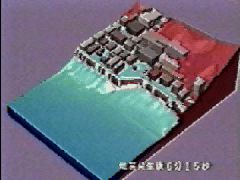What happens when a tsunami encounters land?
As a tsunami approaches shore, we've learned in the "What happens to a tsunami as it approaches land?" section that it begins to slow and grow in height. Just like other water waves, tsunamis begin to lose energy as they rush onshore - part of the wave energy is reflected offshore, while the shoreward-propagating wave energy is dissipated through bottom friction and turbulence. Despite these losses, tsunamis still reach the coast with tremendous amounts of energy. Tsunamis have great erosional potential, stripping beaches of sand that may have taken years to accumulate and undermining trees and other coastal vegetation. Capable of inundating, or flooding, hundreds of meters inland past the typical high-water level, the fast-moving water associated with the inundating tsunami can crush homes and other coastal structures. Tsunamis may reach a maximum vertical height onshore above sea level, often called a runup height, of 10, 20, and even 30 meters.

 This numerical simulation (2.6 MB), produced by Professor Nobuo Shuto of the Disaster Control Research Center, Tohoku University, Japan, shows the 1923 Kanto tsunami attacking a Japanese village. A longer version (6.2 MB) of the this animation is also available. Note that the structures in this model are rigid - in a real-life tsunami, coastal structures often are destroyed. (The QuickTime movie presented here was digitized from a video tape produced from the original computer-generated animation.)
This numerical simulation (2.6 MB), produced by Professor Nobuo Shuto of the Disaster Control Research Center, Tohoku University, Japan, shows the 1923 Kanto tsunami attacking a Japanese village. A longer version (6.2 MB) of the this animation is also available. Note that the structures in this model are rigid - in a real-life tsunami, coastal structures often are destroyed. (The QuickTime movie presented here was digitized from a video tape produced from the original computer-generated animation.)




 This numerical simulation (2.6 MB), produced by Professor Nobuo Shuto of the Disaster Control Research Center, Tohoku University, Japan, shows the 1923 Kanto tsunami attacking a Japanese village. A longer version (6.2 MB) of the this animation is also available. Note that the structures in this model are rigid - in a real-life tsunami, coastal structures often are destroyed. (The QuickTime movie presented here was digitized from a video tape produced from the original computer-generated animation.)
This numerical simulation (2.6 MB), produced by Professor Nobuo Shuto of the Disaster Control Research Center, Tohoku University, Japan, shows the 1923 Kanto tsunami attacking a Japanese village. A longer version (6.2 MB) of the this animation is also available. Note that the structures in this model are rigid - in a real-life tsunami, coastal structures often are destroyed. (The QuickTime movie presented here was digitized from a video tape produced from the original computer-generated animation.)


